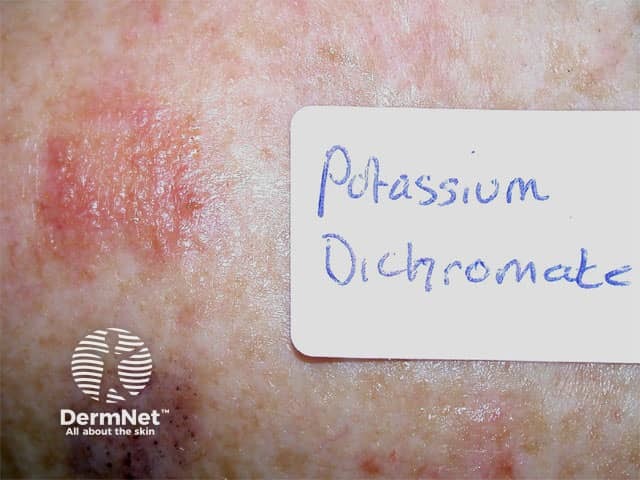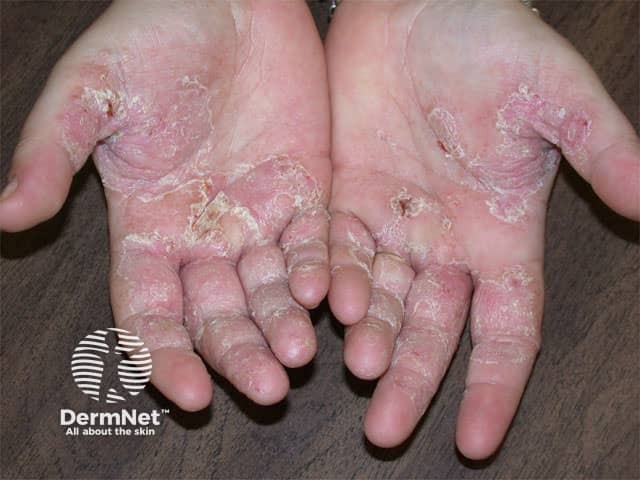Main menu
Common skin conditions

NEWS
Join DermNet PRO
Read more
Quick links
Author: Vanessa Ngan, Staff Writer, 2002. Updated by Dr Jannet Gomez, Medical literature reviewer; Editor in Chief: Dr Amanda Oakley, Dermatologist, Hamilton, New Zealand. October 2019.
Introduction
Sources of chromium salts
Reactions
Diagnosis
Treatment
Prevention
Alternative names
Further information
Chrome allergy presents with a contact allergic dermatitis. It is due to a delayed hypersensitivity reaction to chromium salts (chromates), particularly Cr(III) and Cr(VI).
Chromium salts are used as an ingredient in the manufacture of many other products such as cement, mortar, leather, paints, and anticorrosives.
Although most people associate ‘chrome’ with the bright, shiny and durable finish of chrome-plated metal products, contact with these rarely give rise to chrome allergy. Allergic contact dermatitis due to contact with a metal object is usually caused by nickel.

Positive patch test to potassium dichromate

Chronic hand dermatitis in chrome allergic patient
Most exposure to chromium salts is via the workplace, principally from cement and mortar used in the building industry. There are many other sources of chromates.
Examples include:
Allergic cement dermatitis is usually due to dichromates found in cement and is highest amongst workers handling wet cement. Note that cement also causes irritant contact dermatitis.
Reactions to contact with chromium salts include:
Insertion of intracoronary stents, hip and knee prostheses and other implants containing chromium sometimes undergo failure. These procedures may be associated with various skin problems including eczema, vasculitis and urticaria. It is unknown whether this is a result of an allergic reaction to chrome but this has been suspected in some cases.
Cement dermatitis is most prevalent in construction workers but may occur in artists, DIY homebuilders or other individuals who are exposed to cement through work or a hobby. Dichromates in cement are the cause of the allergic contact dermatitis reactions. Primary irritant reactions of cement dermatitis include dryness and fissuring of the skin caused by the drying (hygroscopic) properties of cement and injury or ulcers to the skin caused by mechanical irritation due to rough silica particles in cement. Individuals can develop cement dermatitis after working for many years without any problems.
Chrome allergy is diagnosed from the clinical history and by performing special allergy tests, called patch tests, using potassium dichromate in petrolatum. Potassium dichromate is present in many baseline series of patch test allergens.
Chrome dermatitis can persist in people even after they change occupations and are no longer exposed to chromates. Approximately two-thirds of those sensitive to chromates will still be allergic even when tested several years later.
Avoidance is the only long-term management strategy for chromate allergy. Dermatitis caused by chromates can become a chronic debilitating problem, so early diagnosis, followed by measures taken to minimise exposure or cease all contact with chromates is key to the management plan. De-sensitisation or hardening to chromates should not be relied upon.
Once dermatitis appears, treatment is as for any acute dermatitis/eczema, with topical corticosteroids, topical calcineurin inhibitors, emollients and treatment of any secondary bacterial infection (Staphylococcus aureus). Treatments for persistent or severe chromate allergy include phototherapy and immune-modulating treatments such as azathioprine, ciclosporin and methotrexate.
Where avoidance is not achievable, several methods have been used to try to minimise exposure.
Some people should also be advised to avoid certain foods with high chromium content, such as tomatoes, broccoli, lettuce and turnips.
In the workplace try to avoid exposure to chromates. However, this may not be practicable thus use measures to minimise exposure as described above. Identify potential sources of exposure using Material Safety Data Sheets; these are required for all chemicals and substances that you may come into contact within the workplace.
Outside of the workplace, the best way to avoid chrome allergy is by being aware of the possible sources of chromates. Wearing thick socks and reducing foot perspiration may help to reduce chromate-induced shoe dermatitis. If possible avoid leather or choose leather items that have been vegetable tanned.
Use only cosmetics that you know do not contain chromates. Avoid direct contact with matches and do not keep matches in clothing pockets. Thoroughly wash all clothes contaminated with chromates.
If you must use products that contain chromates, wear appropriate gloves or other protective clothing to avoid contact with your skin. Your dermatologist may have further specific advice, particularly if you are highly sensitive to chromates.
Chrome is known by several other names. These include:
Avoid all of these. At work, request a material safety data sheet to help identify alternatives that are safe hence avoiding contact with material containing chromates.
CAS number: 7778-50-9
Formula: Cr2K207 (the hexavalent form of chromium)
Cross-reactions:
Sensitiser:
Main sensitisers are the dichromates
Patch Test:
0.25–0.5% potassium dichromate in petrolatum